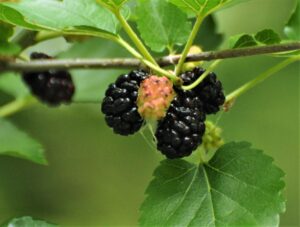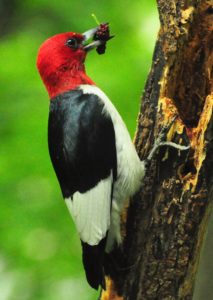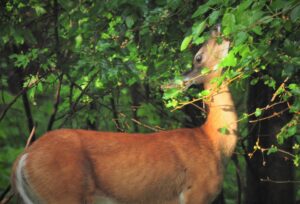Photography courtesy of Lowell Washburn, all rights reserved.
The wild mulberry is one of my favorite summer taste treats. With this year’s mulberry crop currently reaching full maturity, it’s time to grab your bucket and head for the woods.
As healthy as they are tasty, mature mulberries pack a nutritional wallop. A single cupful contains 60 high energy calories: a combined punch derived from 11 grams of unprocessed sugar and 14 natural carbs. That’s more than enough high-octane fuel to make berries worth gathering for birds, deer or human foragers. Speaking of birds and deer, mulberry trees are undisputed wildlife magnets. During June and early July, it seems that everything wearing feathers or fur will be seeking their fair share.
Few wild edibles occur in greater abundance than the common mulberry. Unlike other wild fruits or berries, mulberries produce several crops in rapid succession. Although one of my favorite woodlands only contains two fruit bearing trees, it’s more than enough to attract hungry berry eaters from far and wide. Most of the birds use the trees as a fast-food drive-thru, grabbing a single plump berry and then quickly flying away. Regardless of species, the birds perform as solo acts, coming and going one bird at a time. The deer are a different story. Instead of eating berries one at a time, white-tails guzzle them by the gallon.
Human competition is rarely a factor. Not surprising. Most members of our electronically addicted, hyper-urbanized culture can walk right by a mulberry tree and not even recognize it as food. Those who can identify the species either ignore it completely or regard it as a nuisance because of all the berries it produces. That’s right; considered a nuisance because of all the highly nutritional food it annually produces.
As they grow in size, mulberries turn from a light pink to purple to black. Berries reach their sugary perfection when becoming glossy and jet black. At this stage, the fruit is so ripe that merely giving branches a good shake will cause fruit to fall. Anyone who’s harvested mulberries knows what it’s like to reach for one berry and have a half dozen of their closest neighbors simultaneously drop to the ground. Local deer populations are well aware of this phenomenon. I’ve watched white-tails clamp down on the end of a fruit loaded branch and then shake it vigorously. As the ripe berries rained to the ground, deer standing at the ready eagerly shared in the feast. As soon as the berries were gone, the routine was repeated on an adjacent branch.





 Susan Judkins Josten
Susan Judkins Josten Rudi Roeslein
Rudi Roeslein Elyssa McFarland
Elyssa McFarland Mark Langgin
Mark Langgin Adam Janke
Adam Janke Joe Henry
Joe Henry Sue Wilkinson
Sue Wilkinson Tom Cope
Tom Cope Kristin Ashenbrenner
Kristin Ashenbrenner Joe Wilkinson
Joe Wilkinson Dr. Tammy Mildenstein
Dr. Tammy Mildenstein Sean McMahon
Sean McMahon